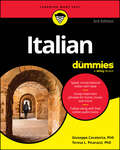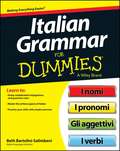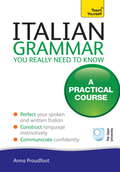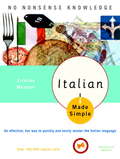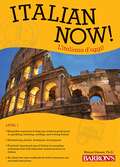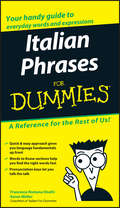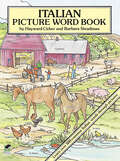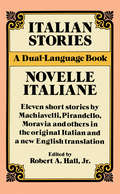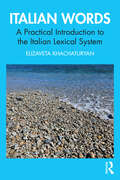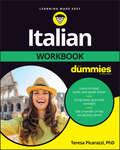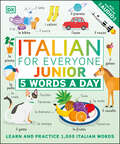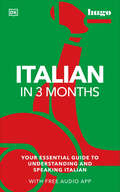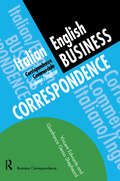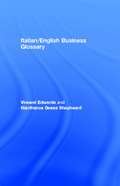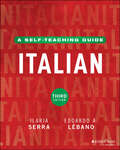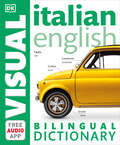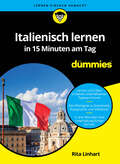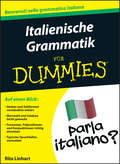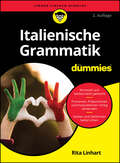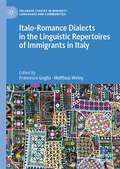- Table View
- List View
Italian For Dummies
by Giuseppe Cavatorta Teresa L. PicarazziThe Dummies language learning method makes it easy to speak Italiano Italian For Dummies is your quick-start guide to the Italian language. It offers friendly and clear instruction on Italian grammar and pronunciation, and even some cultural background to spice things up. You'll also get ample practice opportunities, so you can quickly build your skill in conversational Italian. Traveling to an Italian-speaking country? This book has you covered, with useful travel phrases and a guide to the common words and expressions you're likely to hear. With a mini-dictionary and other helpful resources, Italian For Dummies will show you why Dummies language guides are popular with students and travelers alike. Learn the basics of Italian grammar and start speaking the language right away Prepare to travel to Italian-speaking countries for work, school, or pleasure Work through authentic conversations in Italian to learn how the language is really spoken, plus follow along with online audio Master Italian pronunciation so you can communicate effectively For anyone wanting to grasp the basics of conversational Italian—even if you have no prior experience—Italian For Dummies will get you started with this beautiful language.
Italian Grammar For Dummies
by Beth Bartolini-SalimbeniMaster the written aspects of Italian? Easy.Grammar is one of the most difficult aspects to master when learning a language. The various parts of speech, verb tenses, conjugations, and moods are the building blocks of the Italian language, and must be thoroughly understood in order to be truly fluent. Italian Grammar For Dummies is your first step toward mastering the written aspects of Italian.By emphasizing the complicated conjugations and grammar rules, taking a narrower focus to improve comprehension, and enabling you to practice using the concepts right in the book, Italian Grammar For Dummies is your hands-on guide to mastering the written aspects of Italian.Provides ample opportunities to practice proper Italian grammarServes as an excellent course supplement for those struggling with the complexities of the languageOffers instruction and practice exercises for both speaking and writing the language, giving you greater confidence in your ability to communicate in ItalianIf you're looking to master fluency in the Italian language but struggle with the details of grammar, Italian Grammar For Dummies has you covered.
Italian Grammar You Really Need To Know: Teach Yourself
by Anna ProudfootComprehensive and clear explanations of key grammar patterns and structures are reinforced and contextualized through authentic materials. You will not only learn how to construct grammar correctly, but when and where to use it so you sound natural and appropriate. "Italian Grammar You Really Need to Know will help you gain the intuition you need to become a confident communicator in your new language.
Italian Grammar You Really Need To Know: Teach Yourself
by Anna ProudfootComprehensive and clear explanations of key grammar patterns and structures are reinforced and contextualized through authentic materials. You will not only learn how to construct grammar correctly, but when and where to use it so you sound natural and appropriate. "Italian Grammar You Really Need to Know will help you gain the intuition you need to become a confident communicator in your new language.
Italian Made Simple
by Cristina MazzoniWhether you are planning a romantic Italian getaway, packing a knapsack for your junior year abroad, or just want to engage your Italian business associate in everyday conversation, Italian Made Simple is the perfect book for any self-learner. Void of all the non-essentials and refreshingly easy to understand, Italian Made Simple includes:* basics of grammar* vocabulary building exercises* pronunciation aids* common expressions* word puzzles and language games* contemporary reading selections* Italian culture and history* economic information* Italian-English and English-Italian dictionariesComplete with drills, exercises, and answer keys for ample practice opportunities, Italian Made Simple will soon have you speaking Italian like a native.From the Trade Paperback edition.
Italian Now! Level 1, 2nd edition: L'italiano D'oggi!
by Marcel DanesiA Simon & Schuster eBook. Simon & Schuster has a great book for every reader.
Italian Phrases For Dummies
by Francesca Romana Onofri Karen Antje MöllerEveryday conversations in Italian made easy Italy is a perennially popular destination for Americans, with three cities (Florence, Rome, and Venice) among the top ten in Travel & Leisure's 2003 "World's Best Cities" poll. This concise, easy-to-use guide helps travelers and students get up to speed fast on conversational Italian, showcasing the most commonly used words and phrases. Francesca Romana Onofri is an Italian translator and teacher. Karen Moller is a writer who has worked on several Italian-language projects for Berlitz.
Italian Phrases for Beginners: A Foolproof Guide to Everyday Terms Every Traveler Needs to Know (Pocket Guides)
by Gabrielle EuvinoLearn Italiano before you step off the plane! This beginner&’s language guide will make using Italian phrases feel like second nature.This phrasebook is the perfect traveling companion for trips to Italy. You&’ll have everyday terms, popular idioms, conversational phrases, and pronunciation keys when you need them!Have you always wanted to visit Italy? Now, you have a pocket guide that will help you with the phrases and terms you need to feel comfortable asking for directions, ordering food, or talking about the weather and sports. Everything a Traveler Needs to Know Gabrielle Ann Euvino, an Italian language author and teacher, has compiled Italian Phrases for Beginners to introduce you to more than basic phrases. The book provides you with nuances of common Italian phrases, and modern additions such as commonly used social media and internet terms. Complete the Series There are more books for beginners to discover in this series from DK Books. Pick up new hobbies and skills such as hand lettering through Hand Lettering for Beginners or learn language phrases through books such as Spanish Phrases for Beginners.
Italian Picture Word Book
by Barbara Steadman Hayward CirkerHere’s a pleasant and effective way for students of Italian to build and strengthen vocabulary skills. The book consists of 15 carefully rendered scenes (14 double-page and one single-page), each devoted to a different theme or topic.Lo zoo: At the zooLa fattoria: On the farmLa camera di una ragazza: Girl’s bedroomLa camera di un ragazzo: Boy’s bedroomL’aula scolastica: ClassroomIl soggiorno: Living roomIl bagno: BathroomL’ora di pranzo: At dinnerIl supermercato: SupermarketLa spiaggia: At the beach… and five more.Each illustration contains dozens of common objects, clearly labeled in Italian. By studying the illustrations, students can learn over 500 words for common household items, clothing, foods, vehicles, furniture, names of animals, parts of the body, types of stores and public buildings, and much more.To help reinforce words and meanings, all the scenes in this book are ideal for coloring. In addition, a complete list of Italian words (with definite articles) and English translations will be found at the back of the book. The result is an attractive and useful language resource that will appeal to any student of basic Italian, child or adult.
Italian Stories: A Dual-Language Book (Dover Dual Language Italian Ser.)
by Robert A. Hall Jr.Designed for the language student as well as the lover of fine literature, this convenient dual-language book features eleven great short stories — each one appearing in the original Italian, with vivid and accurate English translations on facing pages.Robert A. Hall, Jr., Professor Emeritus of Linguistics and Italian, Cornell University, has compiled a stimulating and representative collection ranging from a 14th-century selection from Boccaccio's The Decameron to Alberto Moravia's "Competition," a 20th-century view of lower-and middle-class Italian life. Among the other works are Machiavelli's "Belfagor; Story of the Devil Who Took a Wife," Matteo Bandello's reflections of 16th-century morals in "Madonna Zilia," Giovanni Verga's objective portrayal of lower-class Sicilian life in "Rosso Malpelo," Gabriele d'Annunzio's revelations of a depraved peasantry in "The Idolaters," Luigi Pirandello's fascinating study of hypocritical social attitudes in "The Tight Frock Coat," as well as equally significant works by Antonio Fogazzaro, Renato Fucini, Aldo Palazzeschi, and Corrado Alvaro. Arranged chronologically so that the growth of the literary art may be followed, as well as enjoyed, each story is prefaced by a concise biographical/critical introduction. Also included are linguistic and cultural notes, a valuable Italian-English vocabulary, study questions on each story, and an informative essay on Italian fiction. Students of the Italian language will find the dual-language format timesaving and extremely helpful; readers of Italian literature will want to add this treasury of small masterworks to their personal libraries.
Italian Super Review
by George Grätzer E. WilkinsGet all you need to know with Super Reviews! Each Super Review is packed with in-depth, student-friendly topic reviews that fully explain everything about the subject. The Italian Super Review covers pronunciation, verb tenses, sentence structure, grammar, vocabulary, and more! Take the Super Review quizzes to see how much you've learned - and where you need more study. Makes an excellent study aid and textbook companion. Great for self-study! DETAILS - From cover to cover, each in-depth topic review is easy-to-follow and easy-to-grasp - Perfect when preparing for homework, quizzes, and exams! - Review questions after each topic that highlight and reinforce key areas and concepts - Student-friendly language for easy reading and comprehension - Includes quizzes that test your understanding of the subject
Italian Without Words
by Don Cangelosi Joseph Delli CarpiniYou don't need words to speak Italian! You don't have to study Italian or travel to Italy to communicate like a true paesano. All you really need is this unique "phrase book" of Italian body language. It's the fastest, and funniest, way to learn Italian ever published. Now, even if you don't know a single word of Italian, you can learn the most common greetings, dining small talk, bargaining tricks, hot vows of love, vicious threats and blood curdling curses. This book shows you how. There's no faster or funnier way to learn how to communicate in Italy, Italian restaurants, with your grandparents or your friends.
Italian Words: A Practical Introduction to the Italian Lexical System
by Elizaveta KhachaturyanItalian Words: A Practical Introduction to the Italian Lexical System offers a detailed description of the Italian lexicon, explaining the organization of Italian words in a system and the function of this system.What is a word and what is typical of Italian words? How are words’ meaning described and how are words assigned to objects? How are words (seen as lexical items) connected? How was the first dictionary of Italian created? What can we learn about the world and about the speaker through the words used? The book provides answers to these, and other similar questions.Key features: - words in a system: the book provides readers with a theoretical framework integrated with practical strategies and effective exercises to enhance readers’ vocabulary acquisition and to develop analytic skills and linguistic competence; - cross-linguistic comparisons: the book offers a broad perspective on language lexical system (in general) and highlights the specific features of the Italian words, comparing them with English, French, and Norwegian words; - cultural insights: the book demonstrates the interconnectedness of language and culture and describes some features of Italian society through the lens of the words analyzed in the book.This book is ideal for intermediate to advanced students of Italian and can be used alongside a grammar or textbook. It will also be a valuable read for anyone interested in or looking to learn more about the Italian language and culture.
Italian Workbook For Dummies
by Teresa L. PicarazziLearning Italian is easy with Dummies Italian Workbook For Dummies is for beginners who want to get started learning Italian. Packed with foundational grammar and integrated vocab, Italian Workbook For Dummies will set new language learners on their way to a wonderful experience learning this beautiful romance language. This book provides valuable practice lessons and exercises so that you can learn to write and communicate in Italian with confidence. Italian Workbook For Dummies is also an excellent supplement for any student looking to boost their classroom learning. With the tried-and-true expertise of Dummies, you'll move through the Italian basics with ease. Get introduced to the Italian language, including basic grammar and pronunciation Complete exercises to improve your ability to write and speak in Italian Learn important phrases for travelling, doing business, and studying in Italy Build your vocabulary, discover common slang, and learn authentic expressionsThis is the perfect Dummies guide for those who are brand new to the Italian language, regardless of age or background. Gain the confidence you need to interact in Italiano!
Italian for Everyone Junior: 5 Words a Day (DK 5-Words a Day)
by DKLearn, test, and practice your Italian — five words a day!The colorful and illustrated workbook makes learning Italian fun! Each day, children learn five new words that they can listen to, write down and say aloud — an excellent foundation for your child&’s journey to language learning.Discover the perfect introduction to Italian for children ages 6-9. It&’s the ultimate Italian lesson book for kids! It includes: • Beautifully illustrated scenes that teach and test five words at a time. New vocabulary is practiced again at the end of each week in two pages of exercises. • Clever flaps on the jacket that cover the scene so your child can practice what they have just learned. • Uses the effective rote-learning method to teach new vocabulary. • Teaches a range of nouns and verbs that are useful in everyday life. Audio is available online and via a handy app to help with pronunciation. Help your child with Italian vocabularyLearning a foreign language is one of the best ways to develop your child&’s cognitive and language abilities. What&’s more, children gain insight into other cultures and their linguistic nuances. This language book covers Italian vocabulary, Italian pronunciation and makes learning the first Italian words easy and fun. Illustrations, exciting scenes and audio recordings allow your child to fully immerse themselves in their Italian language-learning journey!Italian for Everyone Junior 5 Words a Day encourages kids to copy the nouns and verbs related to each scene in the book, to test their knowledge by covering the words with jacket flaps, and learn one new Italian word every day. More titles in the series to exploreThe colorful, clear and comprehensive 5 Words a Day series from DK lays the foundations for your child's journey in learning a foreign language, at school or at home. Look out for other workbooks in the series! Help your child learn, practice, and understand 1,000 French words in French for Everyone Junior: 5 Words a Day.
Italian in 3 Months with Free Audio App: Your Essential Guide to Understanding and Speaking Italian (DK Hugo in 3 Months Language Learning Courses)
by Milena ReynoldsMaster the Italian language in 3 months and become an extraordinary linguist!If you have ever dreamed about learning the Italian language but think it will be a long and complicated process, you now have a better option! Achieve an impressive goal and learn a new language in as little as 12 weeks.This educational Italian language guide has a newly updated look and an impressive accompanying audio app to get you speaking, reading and writing in Italian. It includes: • "Imitated pronunciation" sections that make unfamiliar Italian sounds less daunting to English learners • Word lists, key phrases and model sentences that build vocabulary • Three self-assessment sections that allow the learner to engage with their own learning, and exercises follow each grammar lesson, reinforcing what has just been taught • Includes two mini bilingual dictionaries, meaning you can check words in both English and Italian Take out the anxiety and fear of learning Italian with the latest edition of this classic self-study course providing all the resources needed to speak, read and write in Italian quickly and effortlessly. Whether you’re a complete beginner or want to refresh your knowledge, Hugo: Italian in Three Months will have you speaking Italian in just 12 weeks.This carefully structured grammar-based course contains 12 weekly chapters filled with informative lessons on the key grammatical structures and presents a range of useful vocabulary, along with easy-to-follow exercises to boost your learning. It helps develop and refine reading, writing, listening and speaking skills, and teaches approximately 4,000 words.This updated language guide now includes vocabulary and expressions in contemporary usage and develops conversation skills through exercises based on real-life scenarios giving you an amazing authentic feel of the language. Whether you’re learning a new language for work, a future vacation or as a hobby, the Hugo language course series is the perfect place to start. Learn languages like French, Dutch, German or Spanish in only 12 weeks! Each course includes an audio app to help with understanding and pronunciation. Language learning has never been so easy!
Italian/English Business Correspondence (Languages For Business Ser.)
by Vincent Edwards Gianfranca Gessa ShepheardItalian/English Business Correspondence is a handy reference and learning text for all who use written Italian. 80 written communications are simply presented covering memos, letters, faxes and resumes. The situations covered include:*Arranging meetings*Acknowledging orders*Enquiring about products*Applying for jobsWith full English translations, this text is suitable for both students and professionals and can be used for either reference or class use.
Italian/English Business Glossary (Business Language Glossaries Ser.)
by Vincent Edwards Gianfranca Gessa ShepheardThis is an essential reference companion to all who use Italian for business communication.Containing over 5000 words, this handy two-way A-Z glossary covers the most commonly used terms in business. It will help you to communicate with confidence in a wide variety of business situations, and is of equal value to the relative beginner or the fluent speaker.Written by an experienced native and non-native speaker team working in business language education, this unique glossary is an indispensable reference guide for all students and professionals studying or working in business where Italian is used.
Italian: A Self-Teaching Guide
by Ilaria SerraLearn Italian at your own speed with tons of hands-on practice In the newly revised third edition of Italian: A Self-Teaching Guide, professor and language educator Dr. Ilaria Serra walks you through how to learn Italian the quick and easy way. This book is ideal for anyone looking to master Italian at their own pace, whether you're approaching the language for the first time or just brushing up on the basics. Italian: A Self-Teaching Guide contains fifteen simple lessons that show you how to engage in everyday conversations, from ordering food at a restaurant to making travel arrangements with a hotel concierge or an Airbnb host. The author helps you develop the skills you need to have actual Italian conversations with actual people in the real world. You'll also find: Straightforward instructions and sample mini-dialogues on how to arrange a ride share and conduct other travel business Help with speaking to a mechanic or a doctor in Italian so you can visit Italian-speaking countries with added confidence Extensive vocabulary and culture notes, along with a fun assortment of exercises, self-tests, and practice activities Easy and complete grammar explanations Self-check solutions An exciting and essential resource for everyone who wants to tackle Italian at their own speed, Italian: A Self-Teaching Guide remains the gold standard in books that teach you how to speak, read, write, and understand the language. It's perfect for students, jobseekers, world travelers, and the simply curious everywhere.
Italian–English Bilingual Visual Dictionary (DK Bilingual Visual Dictionaries)
by DKNewly revised and updated, the Italian-English Bilingual Visual Dictionary is a quick and intuitive way to learn and recall everyday words in Italian. The Italian-English Bilingual Visual Dictionary introduces a range of useful current vocabulary in thematic order, using full-color photographs and artworks to display and label all the elements of everyday life — from the home and office to sport, music, nature, and the countries of the world — with panel features on key nouns, verbs, and useful phrases. The Italian-English Bilingual Visual Dictionary features: A quick and intuitive way to learn and remember thousands of words. A complete range of illustrated objects and scenes from everyday life. Fast and effective learning for any situation, from home and office to shopping and dining out. Detailed index for instant reference. Handy size ideal for travel. The illustrations in the Italian-English Bilingual Visual Dictionary provide a quick and intuitive route to learning a language, defining the words visually so it is easier to remember them and creating a colorful and stimulating learning resource for the foreign-language and EFL/ESL student.
Italienisch lernen in 15 Minuten am Tag für Dummies (Für Dummies)
by Rita LinhartNur ein Viertelstündchen Italienisch am Tag Sie wollen Italienisch lernen, aber der Gedanke, stundenlang Vokabeln und Grammatik zu pauken, schreckt Sie ab? Dann ist dieses Buch genau das Richtige für Sie! In kurzen, auf 15 Minuten pro Tag begrenzten Lektionen bringt es Ihnen auf unterhaltsame Weise die italienische Sprache näher. So erfahren Sie im Handumdrehen alles Wichtige über Grammatik, Aussprache und typische Redewendungen. Anhand zahlreicher Übungen können Sie Ihr Wissen testen und mithilfe des zum Download verfügbaren Audiomaterials auch die Aussprache üben. Nach nur drei Monaten beherrschen Sie die Grundlagen spielend. Sie erfahren Wie Sie in jeder Situation die richtigen Worte finden Mit welchen Redewendungen Sie brillieren Welche Wörter Sie nicht verwechseln sollten Wie Sie Italienisch richtig aussprechen
Italienische Grammatik für Dummies (Für Dummies)
by Rita LinhartSteht der nächste Test an, haben Sie italienische Kollegen, mit denen Sie sich austauschen wollen, oder möchten Sie in Ihrem Italienurlaub mehr als einfach nur "Grazie" sagen können? Grammatik ist nicht jedermanns Sache und die italienische Grammatik macht es einem auch nicht immer leicht. Rita Linhart kennt die Nöte der Lernenden und die Fallen der italienischen Grammatik, in die sie häufig hineintappen. Leicht verständlich, mit einer Prise Humor und anhand vieler Beispiele und Informationen zu Land und Leuten erklärt sie alles über Artikel und Pronomen, Adjektive und Adverbien, Fragestellung und Verneinung, die Zeiten und die Satzstellung. Am Ende eines jeden Kapitels gibt es Übungen, die das Gelernte noch einmal wiederholen. Tabellen der wichtigsten italienischen Verben bieten ganz Eiligen alle Konjugationen auf einen Blick. So sind Sie für den nächsten Test gerüstet, können mit Ihren italienischen Kollegen über zukünftige Projekte sprechen oder einfach nur unbeschwert im Italienurlaub parlieren.
Italienische Grammatik für Dummies (Für Dummies)
by Rita LinhartAuf qui und auf qua – L’ accento non va Steht der nächste Test an, haben Sie italienische Kollegen, mit denen Sie sich austauschen wollen, oder möchten Sie in Ihrem Italienurlaub auch sprachlich »bella figura« machen? Rita Linhart erklärt Ihnen mit einer Prise Humor und anhand vieler Beispiele und Informationen zu Land und Leuten alles über Artikel und Pronomen, Adjektive und Adverbien, Fragestellung und Verneinung, die Zeiten und die Satzstellung. Am Ende eines jeden Kapitels gibt es Übungen, mit denen Sie das Gelernte noch einmal vertiefen können. Tabellen der wichtigsten italienischen Verben bieten Ihnen alle Konjugationen auf einen Blick. Sie erfahren Wie Sie die häufigsten Fallen der italienischen Grammatik vermeiden Welche Logiken Ihnen den Satzbau erleichtern Wie Sie Verben konjugieren Wann Sie welche Zeitformen einsetzen
Italienische Verben (100 Konjugierte Verben)
by Editorial KaribdisNachschlagewerk zur Konjugation der 100 wichtigsten Verben im Italiensischen Verben, besonders geeignet für elektronische Geräte. Zunächst wird in der Einleitung die Bildung aller italienischen Tempora erklärt, im Anschluss werden 100 wichtigen Verben mit Übersetzung vorgestellt. Das Buch ist ohne Bildmaterial konzipiert, damit der Leser leicht entsprechende Textstellen finden kann.
Italo-Romance Dialects in the Linguistic Repertoires of Immigrants in Italy (Palgrave Studies in Minority Languages and Communities)
by Francesco Goglia Matthias WolnyThis edited book brings together experts on the sociolinguistics of immigration with a focus on the Italo-Romance dialects. Sociolinguistic research on immigrant communities in Italy has widely studied the acquisition and use of Italian as L2 by first-generation immigrants, the maintenance of immigrant languages and code-switching between Italian and the immigrant languages. However, these studies have mostly ignored or neglected to investigate immigrant speakers’ use of Italo-Romance dialects, their awareness of the sociolinguistic situation of majority and minority languages, and their attitudes towards them. Given the important role of Italo-Romance dialects in everyday communication and as a marker of regional identity, this book aims to fill this gap and understand more about the role that these languages play in the linguistic repertoire of immigrants. This book will be of interest to students and scholars of sociolinguistics, minority languages, multilingualism, migration, and social anthropology.
